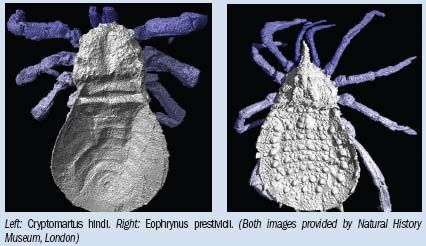Spider fossils! See them in 3D CT!
Unlike Tarantula and other horror films of the 1950s, fossil spiders in 3D CT may not be more terrifying than any creature known to man.
Unlike Tarantula and other horror films of the 1950s, fossil spiders in 3D CT may not be more terrifying than any creature known to man. But the three-dimensional presentations are helping paleontologists discover how the creatures looked and behaved.
Growing to about the diameter of a half dollar, Cryptomartus hindi and Eophrynus prestivicii roamed the Earth during the Carboniferous period, about 325 million years ago, as life was first emerging from the oceans to live on land. Both terrestrial creatures walked on four pairs of legs and looked much like modern spiders.

Scientists at Imperial College in London used microtomography to acquire 3000 CT slices of the fossils and produce volumetric versions of the little critters.
The 3D models indicate that two legs of C. hindi (left) were angled toward the front of its body, suggesting they were used to grab prey. Scientists have theorized that it was an ambush predator, living in logs and on fern fronds, where it waited for insects to walk by.
Spikes on the back of E. prestivicii (right) may have been a defensive adaptation making them less appetizing to amphibians, which had also recently made their first appearances on land. To learn more, go to www.palenews.net/.
Emerging AI Algorithm Shows Promise for Abbreviated Breast MRI in Multicenter Study
April 25th 2025An artificial intelligence algorithm for dynamic contrast-enhanced breast MRI offered a 93.9 percent AUC for breast cancer detection, and a 92.3 percent sensitivity in BI-RADS 3 cases, according to new research presented at the Society for Breast Imaging (SBI) conference.
The Reading Room Podcast: Current Perspectives on the Updated Appropriate Use Criteria for Brain PET
March 18th 2025In a new podcast, Satoshi Minoshima, M.D., Ph.D., and James Williams, Ph.D., share their insights on the recently updated appropriate use criteria for amyloid PET and tau PET in patients with mild cognitive impairment.
Can Abbreviated Breast MRI Have an Impact in Assessing Post-Neoadjuvant Chemotherapy Response?
April 24th 2025New research presented at the Society for Breast Imaging (SBI) conference suggests that abbreviated MRI is comparable to full MRI in assessing pathologic complete response to neoadjuvant chemotherapy for breast cancer.
Clarius Mobile Health Unveils Anterior Knee Feature for Handheld Ultrasound
April 23rd 2025The T-Mode Anterior Knee feature reportedly offers a combination of automated segmentation and real-time conversion of grayscale ultrasound images into color-coded visuals that bolster understanding for novice ultrasound users.